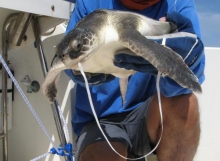
Balloons are a type of marine debris that many people don’t think about. Often used for celebrations or to commemorate special events, balloons are frequently intentionally or accidentally released into the environment. Unfortunately, once they go up, they must also come down; balloons that are released into the air don’t just go away, they either get snagged on something such as tree branches or electrical wires, deflate and make their way back down, or rise until they pop and fall back to Earth where they can create a lot of problems. Balloon debris can be ingested by animals, many of which easily mistake it for real food, and can entangle wildlife, especially balloons with attached ribbons. Balloon debris can even have an economic impact on communities, contributing to dirty beaches which drive away tourists, or causing power outages from mylar balloons covered in metallic paint and their ribbons tangling in power lines. Balloon debris is a national issue and unfortunately, the Mid-Atlantic is not immune.